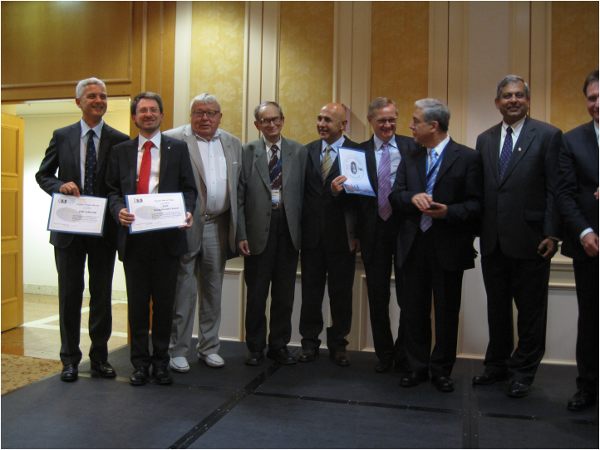ECF-15 conferences of ESIS
In connection with the ECF-15 conference ESIS President Professor Alberto Carpinteri presented the ESIS Awards to the awardees.
From left to right: Professor Fred Nilsson, Professor Hans Richards, Professor Ad Bakker, Professor Alberto Carpinteri

Professor Hans Richard
“Professor Hans RICHARD is awarded the Griffith Medal for his outstanding research in the field of mixed mode fracture of materials an in numerical modeling of complex fatigue crack growth paths, on the occasion of ECF 15, Stockholm, 2004.” |
Hans Albert Richard was born in Brechen, Germany in 1949. He obtained a degree in mechanical engineering from the University of Kaiserslautern in 1974. From 1974 to 1980 he was a scientific assistant in the Institute of Engineering Mechanics, University of Kaiserslautern. In 1979 he was awarded a PhD by the University of Kaiserslautern. His thesis title is ‘Determination of stress intensity factors from photoelastic determined notch stresses’. From 1980 to 1986 he was chief engineer in the Institute of Engineering Mechanics, University of Kaiserslautern. In 1984 he was awarded his postdoctoral lecturer qualification; the thesis title is ‘Prediction of fracture due to overlapping normal- and shear loading as well as pure shear loading of cracks’. Since 1986 he has been Professor of Engineering Mechanics in the Faculty of Mechanical Engineering, University of Paderborn. From 1989 to 1991 Professor Richard was Dean of the Faculty of Mechanical Engineering and from 1991 to 1995 Rector of the University of Paderborn.
From 1985 to 1991 he led the German Working Group on Mixed Mode Problems, and from 1999 to 2003 he was President of the German Fracture Research Group. He has organised national and international Conferences (‘Mixed-Mode-Fracture and Fatigue’, Wien, 1991; ‘Advances in Fracture and Damage Mechanics’, Paderborn, 2003). Professor Richard has over 170 publications in the fields of fracture mechanics and biomechanics. At the University of Paderborn Professor Richard’s work has covered a wide range of topics including strength optimisation and fracture safe design of structures and components, biomechanical analyses of the human musculoskeletal system, new railway technology, product optimisation and new development in cooperation with industry, and failure analysis. Professor Richard has a long standing interest in mixed mode fracture mechanics, dating back to the early 1980s, and this has developed into an interest in crack paths in complex three dimensional situations. Particularly noteworthy is his computer based theoretical prediction of crack paths where he has been able to obtain good agreement with experimental data determined under static and fatigue loading. His work is particularly notable for an innovative approach where he has not been afraid to challenge established wisdom. |
Professor Les Pook
“Professor Leslie POOK is awarded the Wöhler Medal for his outstanding contributions to the understanding of fatigue crack growth behaviour, especially those devoted to mixed mode loading, on the occasion of ECF 15, Stockholm, 2004.” |
Leslie Philip (Les) Pook was born in Middlesex, England in 1935. He obtained a BSc in metallurgy from the University of London in 1956. He started his career at Hawker Siddeley Aviation Ltd, Coventry (HSA) in 1956. In 1963 he moved to the National Engineering Laboratory, East Kilbride, Glasgow (NEL). In 1969, while at NEL he obtained a PhD in mechanical engineering from the University of Strathclyde. Professor Pook moved to the Department of Mechanical Engineering at University College London (UCL) in 1990. He retired formally in 1998, but is still affiliated to UCL as a Visiting Professor, and remains active in research and reaching. Professor Pook has wide experience of both research and practical engineering problems involving metal fatigue, brittle fracture and fracture mechanics. In these fields he has published four books and over 100 papers. He is a Chartered Engineer, a Fellow of the Institution of Mechanical Engineers and a Fellow of the Institute of Materials, Minerals and Mining. At HSA he worked in the Mechanical Test Laboratory (MTL) on the static and fatigue testing of aircraft and guided missile components and structures. Both constant amplitude and block loading were used in fatigue tests. By 1959 interest in the practical application of fractography was increasing and he was asked to investigate this technique. Due to his efforts the use of fractography as an adjunct to both fatigue testing and failure analysis rapidly became routine. Over the next four years he was involved in dozens of fractographic investigations. His work at NEL covered a wide range of topics, including the following. Collaboration with Frost and Denton on the analysis of accumulated fatigue crack growth and threshold data in terms of stress intensity factors. The resulting paper, published in 1971, was very widely cited. Pioneering work on mixed mode fatigue crack growth thresholds resulted in a series of papers (1975-1991). He published a seminal paper on the application of fracture mechanics to spot welds in 1975. He made a major contribution to the development of standard load histories for fatigue testing relevant to offshore structures and this resulted in a series of papers (1976-1989); he published a seminal paper in 1978. Work at UCL covered a wide range of topics, particularly noteworthy are series of papers on topics relevant to the fatigue of offshore structures (1990-1998) and on fatigue crack paths (1992-2003). To some extent this was a period of consolidation and he published two books, in 2000 and 2002. From 1990-1998 he was Editor in Chief of International Journal of Fatigue. In recent years he has been increasingly active in the affairs of the European Structural Integrity Society (ESIS), and he was co-chairman, with Professor Andrea Carpinteri, of the International Conference on Fatigue Crack Paths, sponsored by ESIS, held at the University of Parma, Italy in September 2003. He is a Guest Editor of a forthcoming Special Issue of Fatigue and Fracture of Engineering Materials and Structures which will contain extended versions of selected papers from the Conference. Since formal retirement in 1998 he has maintained his enthusiasm for fatigue but has also found time to pursue interests in horology and in recreational mathematics.
|
Professor Keith Miller
“Professor Keith MILLER is awarded the Award of Merit for his outstanding contributions to the field of fatigue and for his work devoted to the advancement of the European Structural Integrity Society, on the occasion of ECF 15, Stockholm, 2004.” |
The contribution of Keith Miller, ex-president of ESIS, to the study of engineering fatigue and fracture has been immense. A man of prodigious energy, drive and enthusiasm, he has led his university, his country and many international groups in the study of important effects in the failure of engineering mechanical systems. Short cracks and microstructural influences, notches, multi-axial behaviour, mixed mode effects, fretting, and creep-fatigue interactions are just some of the areas in which he has contributed. Having established an internationally recognised research team at Cambridge, he came to Sheffield, his base ever since. His team and influence there grew rapidly. He was a pioneer in recognising the importance of true interdisciplinary work, a major feature in his formation of SIRIUS (Structural Integrity Research Institute Univeristy of Sheffield), a research centre with strong collaboration between three separate university departments. He founded the international journal Fatigue and Fracture of Engineering Materials and Structures early in the life of SIRIUS and was its editor for 22 years. He has been a strong and active supporter of ESIS from the beginning, with special contributions to its publications activities. His efforts in the development of ESIS finally led to a presidency. He was one of the first into China when it opened its doors to outsiders, and he began a rich and continuing stream of research collaborations between Chinese and European engineers and scientists. But his travels have also been driven by his other great love, exploration and mountaineering. He organised and led expeditions all over the world, Greenland, Iceland, Antarctica, the Karakorum included. From this came his contributions to the study of continental drift and the properties of ice.
|
Professor Ad Bakker
“Professor Ad BAKKER is awarded the Honorary Membership for his many valuable contributions to the field of fracture mechanics and for his work devoted to the development of the European Structural Integrity Society, on the occasion of ECF 15, Stockholm, 2004.” |
Ad Bakker has been involved with ESIS and its predecessor, EGF, for many years. He was Secretary-General of EGF, and later of ESIS, from 1984 to 1998 under the presidencies of Harry van Elst, Hannes Larsson, Ian Milne and Dominique François. He was organiser or co-organiser of several major conferences (ECF6, Amsterdam, 1986, ICM7, The Hague, 1987). Professor Bakker was Initiator and Editor of the EGF (later ESIS) Newsletter from 1987 to 1997, a total of 31 issues. He had to stop active participation in ESIS in 1998 because of health problems, but since then he has acted as consultant to the Executive Committee of ESIS (now the Council) on various occasions. General Secretary is a poor description of Professor Bakker’s position: he was also responsible for the finances of ESIS, the membership, the Newsletter, printing and circulation of ESIS reports and documents, attending to external requests, and maintaining external contacts. In replying to external requests and suggestions he was unfailingly courteous. His contribution to EGF and ESIS has been immense, and it is no exaggeration to say that ESIS as it is today is very much a creature of his design. In earlier days, he was more than just General Secretary, but as right hand man to Harry van Elst he did all the leg-work. There are many examples of how Ad Bakker managed the affairs of ESIS beneficially. An important one is that he ensured that ESIS was registered as a non-profit organisation in The Netherlands, thus avoiding the payment of tax. ESIS also benefited from being run within his department at Delft University of Technology, so that many of the costs of the ESIS operation were covered not only directly, but also in kind (secretarial effort, typing the Newsletter, circulating it, etc.). His close involvement with the operation was essential in the drafting of the first edition of the ESIS rules and bye-laws, which followed the change of name from EGF to ESIS. He also gave advice on the myriad of issues which would come up from day to day, and more significantly in the biennial Council meetings. All this was in addition to being Head of Department, running a research team, and writing some significant papers. Just how much Professor Bakker had been doing for ESIS only became completely clear when, in 1998, the ESIS Secretariat was transferred from Delft University of Technology to the University of Sheffield, under Professor Keith J Miller, who also undertook the Presidency of ESIS for two years. |
Table of content
- Professor Hans Richard
- “Professor Hans RICHARD is awarded the Griffith Medal for his outstanding research in the field of mixed mode fracture of materials an in numerical modeling of complex fatigue crack growth paths, on the occasion of ECF 15, Stockholm, 2004.”
- Professor Les Pook
- “Professor Leslie POOK is awarded the Wöhler Medal for his outstanding contributions to the understanding of fatigue crack growth behaviour, especially those devoted to mixed mode loading, on the occasion of ECF 15, Stockholm, 2004.”
- Professor Keith Miller
- “Professor Keith MILLER is awarded the Award of Merit for his outstanding contributions to the field of fatigue and for his work devoted to the advancement of the European Structural Integrity Society, on the occasion of ECF 15, Stockholm, 2004.”
- Professor Ad Bakker
- “Professor Ad BAKKER is awarded the Honorary Membership for his many valuable contributions to the field of fracture mechanics and for his work devoted to the development of the European Structural Integrity Society, on the occasion of ECF 15, Stockholm, 2004.”
Related articles
On the occasion of the 21st European Conference on Fracture in Catania, ESIS President Prof. Leslie Banks-Sills and ECF21 Chairman Prof. Francesco Iacoviello conferred the ESIS Awards: - The Griffith Medal - The Wöhler Medal - The Award of Merit - Honorary Membership - The Young Scientist Award The Wöhler Medal was awarded to[...]
On the occasion of the 20th European Conference on Fracture in Trondheim, ESIS President Prof. Leslie Banks-Sills and ECF20 Chairman Prof. Zhiliang Zhang conferred the ESIS Awards. The Wöhler Medal was awarded to Prof. Reinhard Pippan for his seminal contributions to the effect of severe plastic deformation on fatigue. The Griffith Medal was awarded to Prof. Gordon Williams for[...]
On the occasion of the 18th European Conference on Fracture in Dresden, ESIS President Prof. Gdoutos and ECF18 Chairman Prof. Klingbeil conferred the ESIS Awards: Griffith Medal to Prof. E. Gdoutos ‘‘for his seminal contributions in mixed-mode fracture and failure mechanisms of sandwich structures”. Wöhler Medal to Prof. A. Saxena ‘‘for his outstanding and seminal contributions on[...]








